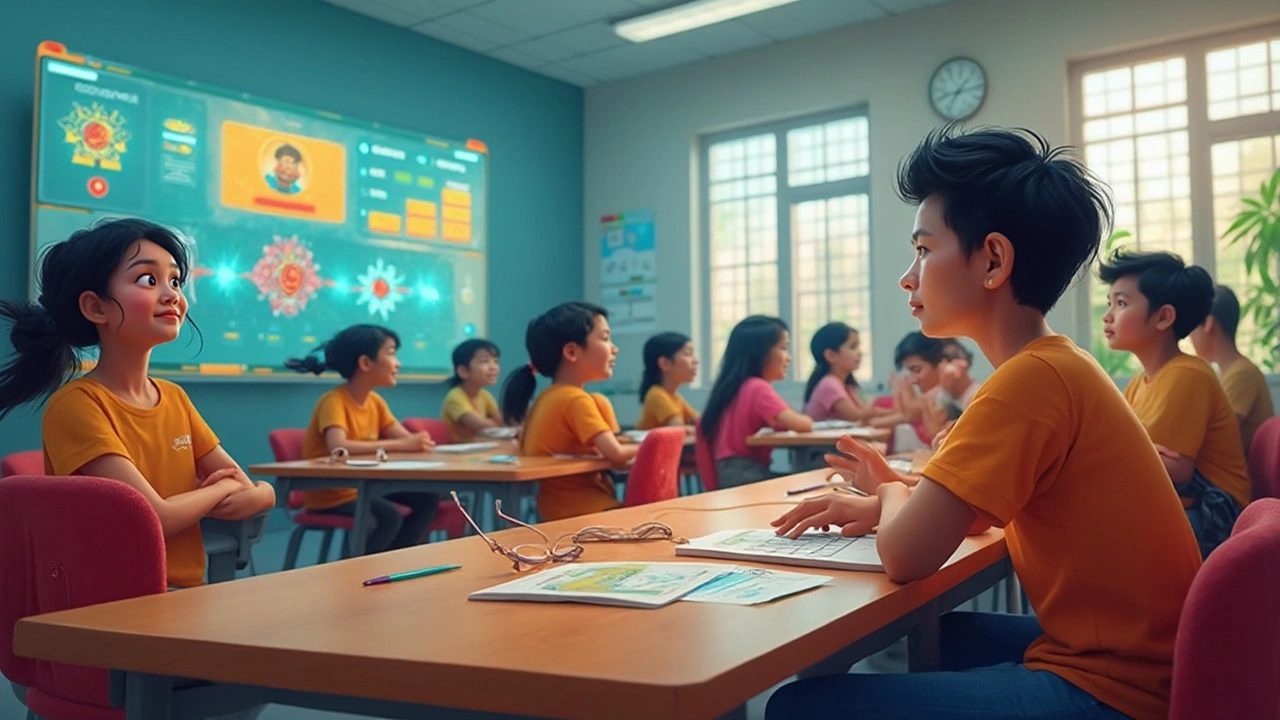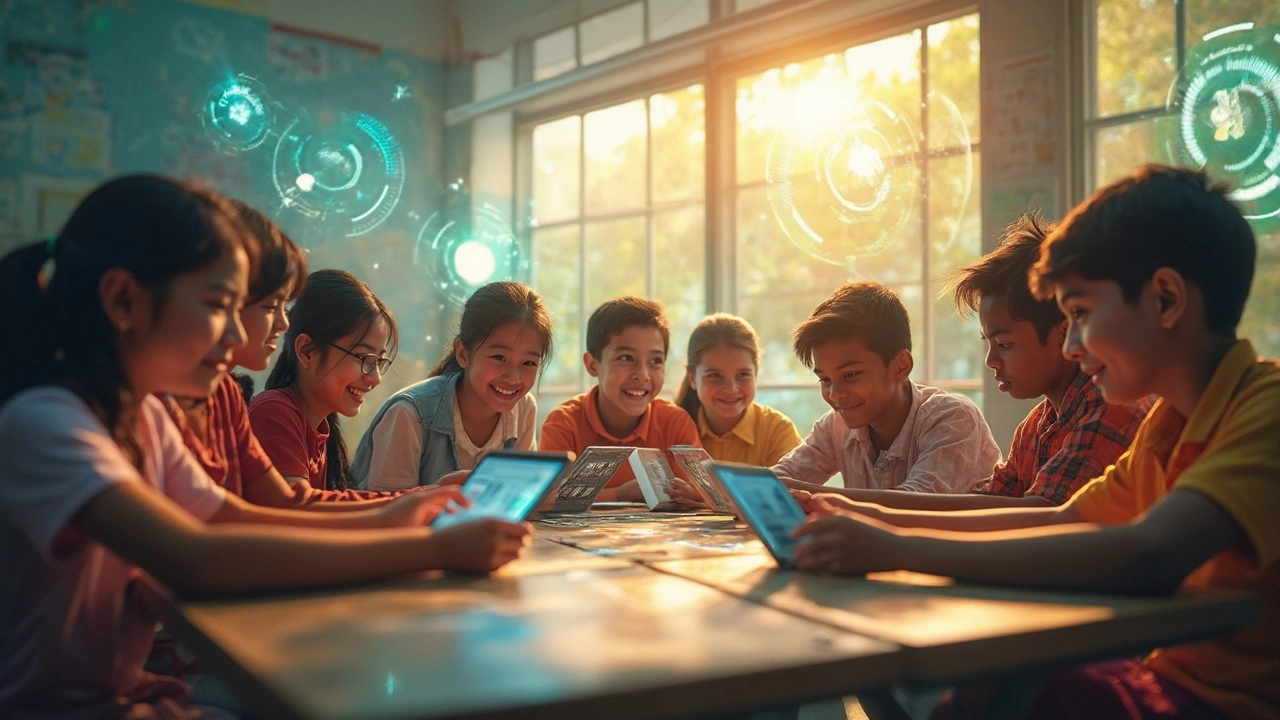Ever wonder why eLearning is getting so much buzz lately? With technology shaping just about everything, it’s no surprise that education is getting a high-tech makeover too. From folks cozying up at home with their laptops to picking up new skills, to teachers managing classes online, eLearning models are popping up everywhere to make it all work smoothly.
So, what's all the hype about? Turns out, these models aren’t just about convenience; they’re redefining how we learn. Picture this: learning at your own pace, mixing online and offline lessons, or diving into games that sneakily educate you while you play. Sounds pretty cool, right? But here's the deal—you gotta pick the model that fits your style and needs. Let’s break down these five to see which one might just be your match made in eLearning heaven.
Blended Learning
Blended learning is like getting the best of both worlds in education. Imagine combining the traditional face-to-face classroom vibe with the flexibility and convenience of online education. That's blended learning for you! It’s no wonder it's becoming a favorite for students and educators alike.
This model is all about mixing in-person teaching with independent online study. So, instead of sticking to one method, you’re tapping into multiple ways of learning. This flexibility allows students to dive deeper into subjects at their own pace while still having the chance to participate in discussions and get hands-on help during physical class sessions.
Schools and colleges are catching on too. For example, in a blended learning setup, you might attend lectures in person a couple of days a week and spend the rest learning online with videos, interactive quizzes, or digital forums. Some universities report that blended learning boosts student engagement by as much as 90%, thanks to this dynamic format.
| Component | Method |
|---|---|
| Classroom | Face-to-Face |
| Online | Independent Study |
To make the most of blended learning, it's crucial to focus on strong time management skills, since the self-paced online part needs personal discipline. Having a reliable device and internet connection doesn’t hurt either! Schools are also investing in tools and platforms that support this model, making it easier for students to access resources anytime, anywhere.
Whether you're a student juggling work and school, or a teacher looking for new ways to engage your class, blended learning offers a flexible approach without completely leaving behind the traditional classroom feel. It’s like choosing your own educational adventure—one that fits your schedule and keeps you interested in learning. Pretty neat, huh?
Flipped Classroom
Alright, let's dive into the flipped classroom concept—it's like turning traditional learning on its head. In this model, what usually happens in class happens at home, and what folks do for homework, they do in class. Confused yet? Let me explain.
Here's the scoop: Instead of sitting through lectures in school, students get to watch video lessons at home. This way, they control the pace—they can pause, rewind, or even re-watch parts that are tough to grasp. The classroom then turns into a workshop where students engage in hands-on activities, discussions, and projects. It’s a real game-changer in the e-learning platforms.
Why is this so awesome? Well, it really maximizes class time. Since students come prepared, teachers can offer more personalized support, tackle advanced topics, or clear up any confusion. It's not about spoon-feeding info; it’s about letting students dig deep and think critically.
Here's a table breaking down the basic difference:
| Traditional Classroom | Flipped Classroom |
|---|---|
| Lecture in class | Lecture at home via video |
| Homework at home | Hands-on activities in class |
If you're considering this for your eLearning gig, keep a few things in mind. First off, students need access to tech and internet to catch those videos at home. And teachers, well, they need to curate or create top-notch video content. But hey, once you get past that hurdle, flipping the classroom can really energize learning and make the most of those classroom interactions.

Self-Paced Learning
Imagine studying where you’re in the driver’s seat, taking control of what and when you learn. That’s what self-paced learning is all about; no need to worry about keeping up with classmates or following a strict schedule.
This model is huge in the world of online education because it gives students the freedom to breathe a bit. Whether you're juggling a job, family, or just prefer going at your own pace, this model is a real game-changer.
Universities and various e-learning platforms use a mix of videos, readings, quizzes, and more to let students dive into the material at their leisure. Want to zip through a chapter you already know? Or maybe slow down and replay a lecture video because something wasn’t clicking? You do you!
A fun fact—this model is popular among adult learners and professionals who are already in the workplace. Why? Because they can fit learning into their schedule without sacrificing work. And employers are getting on board too; they love when employees keep their skills sharp without attending rigid classes.
There's a little something for everyone in self-paced learning. Consider these perks:
- Flexibility to learn whenever and wherever.
- Customization, allowing learners to tailor their studies to individual needs and pace.
- Reduced pressure, as there are no immediate deadlines.
- Freedom to choose how deeply to engage with topics of interest.
So, if you’re someone who likes doing things your way, when you like, self-paced learning could be the perfect fit. Just make sure you're dedicated and disciplined; it’s easy to fall behind when there’s no one pushing you!
Gamified Learning
Gamified learning is like mixing fun and education—the peanut butter and jelly of eLearning models. It's taking the engaging elements from games, like points, levels, and leaderboards, and plopping them right into lessons. Why? Because it makes learning a whole lot more exciting, especially for those who might lose interest with traditional ways.
This approach isn't just for kids or video game enthusiasts, though. Even adults in professional settings are getting hooked on it. Picture yourself at work, racking up points by completing training modules and battling it out on the office leaderboard. It pushes you to keep going, striving for better scores while learning new stuff along the way.
Here’s a cool fact: A lot of companies have seen a boost in employee completion rates after bringing in gamified learning. Imagine turning a boring compliance course into a thrilling quest—sounds better, right? Places like Duolingo have nailed this, making language learning accessible by turning it into a game. You get achievements and virtual rewards for hitting your targets. Who wouldn't want to play their way to learning a new language?
For those deciding whether gamified online education is the right fit, keep in mind these tips:
- Know your audience: Gamification isn't one-size-fits-all. What works for a 10-year-old may not click with a senior executive.
- Set clear goals: People need to know what they're aiming for beyond just playing. Tie gamified elements to clear learning outcomes.
- Keep it simple: Overloading learners with too many elements can backfire. Make it challenging, but not frustrating.
In a nutshell, gamified learning is reshaping the way we approach education, making it interactive and enjoyable. Next time you're getting tripped up by a new topic, look for a course that turns it into a game. You might just find yourself mastering the material faster than you thought possible!

Social Learning
Social learning might sound like a buzzword, but it's actually a game-changer in the world of eLearning models. At its core, it's about learning through interaction and collaboration with others. Instead of sitting in a virtual room alone, imagine bouncing ideas off classmates, working on projects together, and having debates that really make you think. It's the stuff that sticks with you.
Why does this matter in online education? People naturally learn from each other, and social learning taps into that. Think of it as the digital version of having a study group that never sleeps—a community of learners sharing insights and knowledge round the clock.
"Learning is more effective when it is more like a game, not a lecture," says Albert Bandura, a psychologist known for his work on social learning theory. This emphasizes the interactive nature of social learning.
Platforms like Facebook Workplace or Slack aren’t just for business chat—they're being hijacked by educators to foster these collaborative environments. And the informal vibe of these spaces makes learning feel less like a chore and more like a engaging discussion.
Let's have a look at how social learning boosts educational experiences:
- Increased Engagement: When learners feel part of a community, they're more invested in their studies. It's way easier to stay motivated when you're involved and feeling like you're a piece of a bigger puzzle.
- Diverse Perspectives: In a social learning setup, you gain different viewpoints, thanks to chatting with folks from varying backgrounds. It helps broaden your horizons beyond what a single textbook can offer.
- Real-time Feedback: With peers and educators keeping the dialogue flowing, you get instant input, tips, and support.
Oh, and let's not forget about assessments. Some folks are exploring peer review as a way to evaluate understanding. When students critique each other's work, it sharpens their analytical skills and teaches them to view things critically.
| Platform | Key Feature | User Base |
|---|---|---|
| Slack | Channels for focused discussions | 12 million daily active users |
| Microsoft Teams | Seamless integration with Office apps | 270 million monthly active users |
Social learning is all about making e-learning feel personal and connected. So next time you log into a course, think about how you can tap into your peers and turn that lesson into a conversation.






Write a comment: